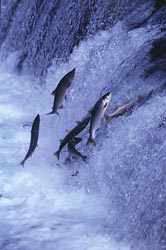Salmon run
Salmon run refers to the annual migration of salmon from the ocean to their natal freshwater streams, rivers, and lakes to spawn. This phenomenon is a critical part of the salmon life cycle and is essential for the reproduction of the species.
Life Cycle[edit | edit source]
Salmon are anadromous fish, meaning they are born in freshwater, migrate to the ocean, and then return to freshwater to reproduce. The life cycle of salmon includes several stages: egg, alevin, fry, smolt, adult, and spawning adult. The salmon run occurs when adult salmon return to the freshwater habitat where they were born to lay their eggs.
Migration[edit | edit source]
The migration of salmon is triggered by a combination of environmental factors such as water temperature, flow, and the length of daylight. During the salmon run, salmon navigate through a variety of obstacles including waterfalls, dams, and predators. They rely on their keen sense of smell to locate their natal stream.
Species[edit | edit source]
Several species of salmon participate in the salmon run, including:
- Chinook salmon (Oncorhynchus tshawytscha)
- Coho salmon (Oncorhynchus kisutch)
- Sockeye salmon (Oncorhynchus nerka)
- Pink salmon (Oncorhynchus gorbuscha)
- Chum salmon (Oncorhynchus keta)
Ecological Importance[edit | edit source]
The salmon run is a vital ecological event. It provides a significant source of nutrients to freshwater ecosystems. When salmon die after spawning, their bodies decompose and release nutrients that support the growth of aquatic plants and the health of the entire ecosystem. This process benefits a wide range of species, including bears, eagles, and other wildlife that feed on salmon.
Human Impact[edit | edit source]
Human activities such as overfishing, habitat destruction, and the construction of dams have significantly impacted salmon populations and their ability to complete their migration. Conservation efforts are in place to protect and restore salmon habitats, including the removal of obsolete dams and the implementation of fish ladders to help salmon navigate around obstacles.
Cultural Significance[edit | edit source]
Salmon runs hold cultural significance for many indigenous peoples, particularly in the Pacific Northwest of North America. These communities have relied on salmon as a staple food source for thousands of years and have developed rich cultural traditions and practices centered around the salmon run.
See Also[edit | edit source]
References[edit | edit source]
External Links[edit | edit source]
Search WikiMD
Ad.Tired of being Overweight? Try W8MD's physician weight loss program.
Semaglutide (Ozempic / Wegovy and Tirzepatide (Mounjaro / Zepbound) available.
Advertise on WikiMD
|
WikiMD's Wellness Encyclopedia |
| Let Food Be Thy Medicine Medicine Thy Food - Hippocrates |
Translate this page: - East Asian
中文,
日本,
한국어,
South Asian
हिन्दी,
தமிழ்,
తెలుగు,
Urdu,
ಕನ್ನಡ,
Southeast Asian
Indonesian,
Vietnamese,
Thai,
မြန်မာဘာသာ,
বাংলা
European
español,
Deutsch,
français,
Greek,
português do Brasil,
polski,
română,
русский,
Nederlands,
norsk,
svenska,
suomi,
Italian
Middle Eastern & African
عربى,
Turkish,
Persian,
Hebrew,
Afrikaans,
isiZulu,
Kiswahili,
Other
Bulgarian,
Hungarian,
Czech,
Swedish,
മലയാളം,
मराठी,
ਪੰਜਾਬੀ,
ગુજરાતી,
Portuguese,
Ukrainian
Medical Disclaimer: WikiMD is not a substitute for professional medical advice. The information on WikiMD is provided as an information resource only, may be incorrect, outdated or misleading, and is not to be used or relied on for any diagnostic or treatment purposes. Please consult your health care provider before making any healthcare decisions or for guidance about a specific medical condition. WikiMD expressly disclaims responsibility, and shall have no liability, for any damages, loss, injury, or liability whatsoever suffered as a result of your reliance on the information contained in this site. By visiting this site you agree to the foregoing terms and conditions, which may from time to time be changed or supplemented by WikiMD. If you do not agree to the foregoing terms and conditions, you should not enter or use this site. See full disclaimer.
Credits:Most images are courtesy of Wikimedia commons, and templates, categories Wikipedia, licensed under CC BY SA or similar.
Contributors: Prab R. Tumpati, MD




